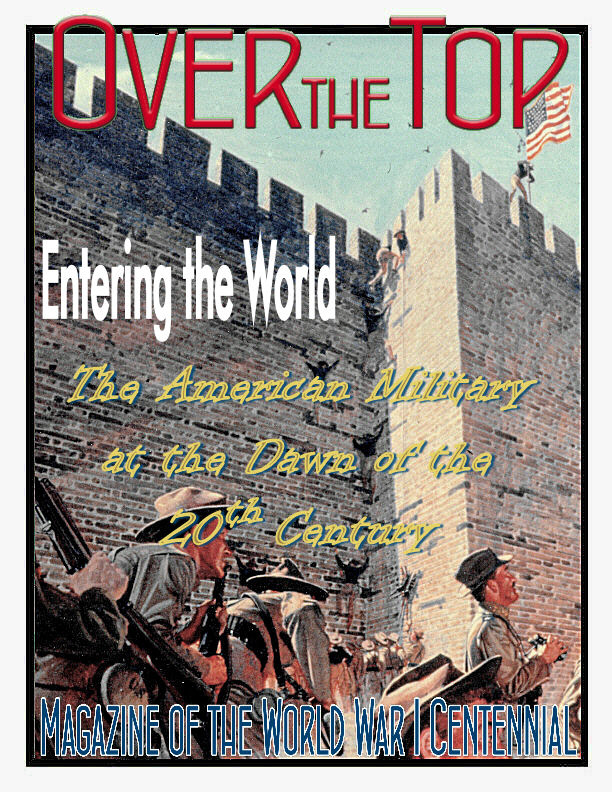
April-May 2014 |
 |
|


My Battlefield Season Has Arrived
Our long-time readers will remember that it is just impossible for me to crank out a full issue of the St. Mihiel Trip-Wire while I'm leading groups around the Western Front. This year — with two trips — I am combining my April and May issues while my group is visiting the opening battlefields in Belgium and France and will be doing the same in August and September prior to my Battle of the Marne trip.
On the other hand, I've discovered I can keep posting our daily blog, Roads to the Great War (link) from my laptop while I'm on the move. So we will have a new article every day there while I'm away. I've been surprised by the lack of crossover readership between the two sites, so I hope you will become a visitor. I assure you, if you enjoy the Trip-Wire, you will also like Roads.
I've provided some samples for you over in the right column in our "History on the Internet" feature. These are some of our most popular postings. If you like what you see, just enter your email in the "Follow Roads by Email" box in the right column of the blog.
M,H

|
2014
 Western Front Association Spring WWI History Symposium: "First Centenary Program," Maryland War Memorial, Baltimore, Sat. 7 June 2014 Download Event Flyer. Western Front Association Spring WWI History Symposium: "First Centenary Program," Maryland War Memorial, Baltimore, Sat. 7 June 2014 Download Event Flyer.
 West Point Announces First World War Conference: "Literature, Memory, and the First World War," 11-14 September 2014 Details, Registration, and Call for Papers. West Point Announces First World War Conference: "Literature, Memory, and the First World War," 11-14 September 2014 Details, Registration, and Call for Papers.
 The 2014 Charles Burdick Military History Symposium: "The First World War," 19 April 2014, San Jose State Univ. Flyer and Program. The 2014 Charles Burdick Military History Symposium: "The First World War," 19 April 2014, San Jose State Univ. Flyer and Program.
 WW1HA-Southwest Chapter & Tarleton University, Stephenville, Texas, Announce a Joint WWI Conference: "Americans Involved in the War Before April 1917," 10-11 October 2014 Email for Details and Call for Papers. WW1HA-Southwest Chapter & Tarleton University, Stephenville, Texas, Announce a Joint WWI Conference: "Americans Involved in the War Before April 1917," 10-11 October 2014 Email for Details and Call for Papers.
 The National World War I Museum in Kansas City, MO, has a new exhibit "On the Brink," running through 14 September. (Feature Article Below) Visit Website. The National World War I Museum in Kansas City, MO, has a new exhibit "On the Brink," running through 14 September. (Feature Article Below) Visit Website.
 The MacArthur Memorial and Museum in Norfolk, VA: (1) Exhibit — "The 42nd 'Rainbow' Division in World War One," through September 2014; (2) Symposium — 14-15 November 2014, 10:00 a.m.-5:00 p.m., "World War I Centennial;" Free and Open to the public. More details to follow. Website. The MacArthur Memorial and Museum in Norfolk, VA: (1) Exhibit — "The 42nd 'Rainbow' Division in World War One," through September 2014; (2) Symposium — 14-15 November 2014, 10:00 a.m.-5:00 p.m., "World War I Centennial;" Free and Open to the public. More details to follow. Website.
 The U.S. Air Force National Museum at Wright-Patterson AFB, OH, and the League of WWI Aviation Historians (OvertheFront.com), are collaborating on what will be the first U.S.-based mega-event for the WWI centennial. The League is scheduling its 2014 Seminar to correspond with the WWI Dawn Patrol Fly-In at the Museum in Dayton, OH, 24-28 September 2014. Mark it down on your calendar. The U.S. Air Force National Museum at Wright-Patterson AFB, OH, and the League of WWI Aviation Historians (OvertheFront.com), are collaborating on what will be the first U.S.-based mega-event for the WWI centennial. The League is scheduling its 2014 Seminar to correspond with the WWI Dawn Patrol Fly-In at the Museum in Dayton, OH, 24-28 September 2014. Mark it down on your calendar.
|
|
Children's Postcard
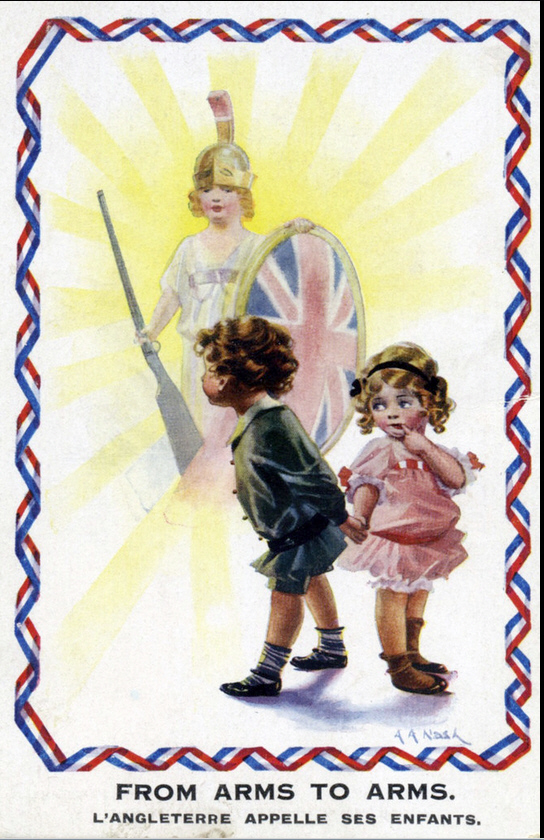
"England Calls Its Children"

Roads to the Great War
For our readers who need a daily dosage of WWI fare, the editors of the Trip-Wire have also been publishing a daily blog, Roads to the Great War, for nearly a year. If you're not a regular visitor, please check this list of our seven most popular articles. If you like what you see, you can register to receive a daily announcement about the latest posting.
 The German Experience at the Battle of the Somme
The German Experience at the Battle of the Somme
 Queen Victoria's Ghost: Her Majesty's 1914 European Family
Queen Victoria's Ghost: Her Majesty's 1914 European Family
 Panoramic Images from the Library of Congress
Panoramic Images from the Library of Congress
 Remembering a Veteran: Sgt. Alan L. Eggers, 107th Machine Gun Company, 27th Division, AEF, Contributed by James Patton
Remembering a Veteran: Sgt. Alan L. Eggers, 107th Machine Gun Company, 27th Division, AEF, Contributed by James Patton
 The 1918 Road to Damascus: Over the Golan Heights, Photos by Steve Miller
The 1918 Road to Damascus: Over the Golan Heights, Photos by Steve Miller
 Your World War I Poetry Library by David Beer
Your World War I Poetry Library by David Beer
 The War on the Home Front: Kill the Squirrels!
The War on the Home Front: Kill the Squirrels!

Who Is This Notable WWI Aviator?
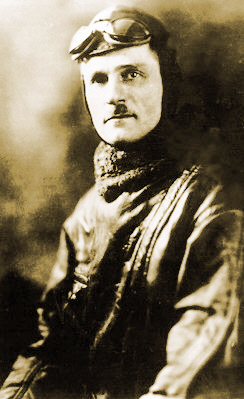
Clues: He was with Pershing in Mexico; held training and operational air commands with the AEF; became a brilliant innovator between the wars; commanded strategic bombers in two WWII theaters; and became first Chief of Staff of the U.S. Air Force.
Answer below.

The Forest of the Dead
With loving or unloving eye
Kinsman and alien pass them by:
Do the dead know, do the dead care,
Under the forest as they lie?
Capt. J. Griffyth Fairfax, R.A.S.C.
|

|

U.S. Centennial Organizations & Resources
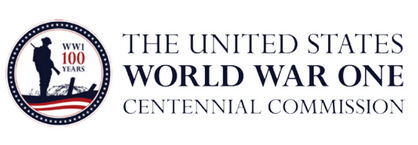
worldwar-1centennial.org/
|
President Honors U.S. World War I Fallen at
Flanders Fields Cemetery

Belgian Prime Minister Elio Di Rupo, King Philippe, and President Obama Salute the Fallen
On 26 March President Obama visited the U.S. Flanders Fields Cemetery at Waregem, Belgium, with the Belgian King and Prime Minister to remember the American contribution to liberating Belgium in 1918. The party laid wreaths and the President made comments that included a quote from John McCrae's poem "In Flanders Fields" and a reference to the use of chemical weapons, then and now:
Here today, I'd also note that the lessons of that war speak to us still. Our nations are part of the international effort to destroy Syria's chemical weapons—the same kinds of weapons that were used to such devastating effect on these very fields. We thought we had banished their use to history, and our efforts send a powerful message that these weapons have no place in a civilized world. This is one of the ways that we can honor those who fell here.
The U.S. Cemetery in Flanders was built and is operated by the American Battle Monuments Commission. It holds 368 graves and remembers 43 missing in action in the region. Most Americans do not associate the nation's war effort with Flanders, but nearly 100,000 of their countrymen served there in the last six months of the war, serving either under British command or King Albert's group of armies.
U.S. Centennial Commission Conference & Trade Fair
Set for Washington, DC
14 June 2014
The United States World War One Centennial Commission has announced an opportunity for historians, educators, curators, cultural programmers, authors, re-enactors, students, and other enthusiasts to gather in Washington, DC on June 14 to discuss the upcoming centennial commemoration, share information, and develop partnerships.
The information-sharing and networking event will take place 1:30-5:00 p.m. EDT at the offices of Jones Day, 300 New Jersey Avenue, N.W., Washington, DC 2001. Advance registration is required. You can RSVP to rsvp@worldwar1centennial.org
by 15 May if you intend to attend this event.
Participants will receive a briefing by the commission on its strategic plan. Discussion of opportunities to partner with the Commission will also take place. Individuals and organizations will make presentations on their centennial programming.
The "trade fair" will provide the opportunity to display materials on commemorative programs and capabilities to attendees seeking ideas and services for state and local commemoration activities and events.
On the Brink:
A Month That Changed the World
at the National WWI Museum
For many years hatred against the Monarchy has been sown in Servia. The crop has sprung up and the harvest is murder.
Ritter von Storck, Austria-Hungary Secretary of Legation in Belgrade,
on 29 June 1914
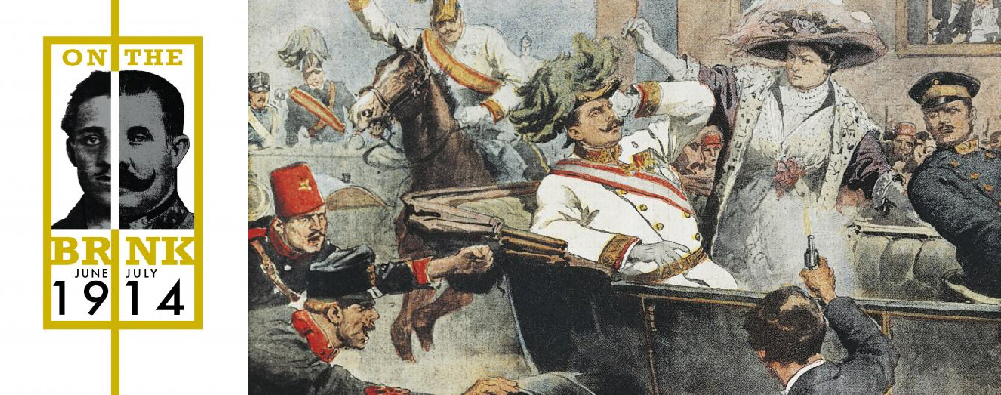
A hungry teenage assassin and a wrong turn. The two bullets fired on 28 June 1914 outside of a delicatessen in Sarajevo, the capital of Bosnia-Herzegovina, placed the world “on the brink” and led to a sequence of events that changed the world forever. Secret societies and nationalist organizations strove for an independent Slavic nation free from foreign domination, unknowingly represented on that fateful day by the Archduke Franz Ferdinand, heir to the Austro-Hungarian throne.
On the Brink: A Month That Changed the World examines the underground organizations, diplomatic communications, and international newspaper reporting of the assassination and its political aftershock. The exhibition presents the assassination in a manner never seen before. The assassination was the pretext for the Austro-Hungarian Empire to declare aggressive action, with the intention of a short-lived conflict, in its long-standing feud with Serbia. A war declared between an empire and its neighbor on 28 July 1914 resulted by the end of August in combatant nations from five continents involved in the world's first global conflict.
This special exhibition was created with support from the Austrian National Archives, Serbian National Archives, Library of Congress, Kansas City Public Library and the British Library. Open from 15 March to 14 September in Memory Hall, National World War I Museum at the Liberty Memorial, Kansas City, MO.
Let Us Help Publicize Your Local WWI Events & Research!
(Email the Editor)
|
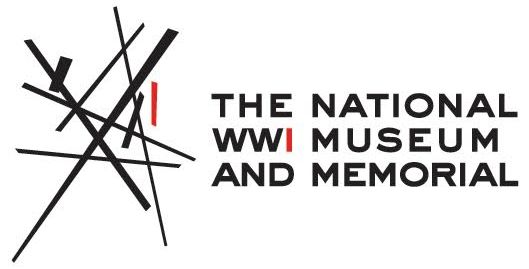
theworldwar.org/
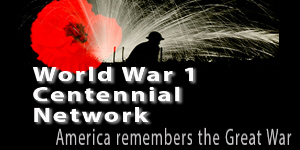
www.ww1-centennial.org/

history.army.mil/
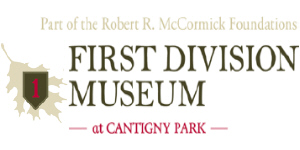
www.firstdivisionmuseum.org/

www.abmc.gov/
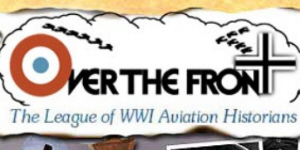
www.overthefront.com/
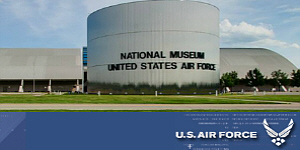
www.nationalmuseum.af.mil/
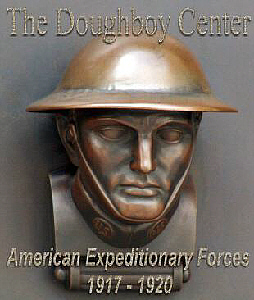
www.worldwar1.com/dbc/
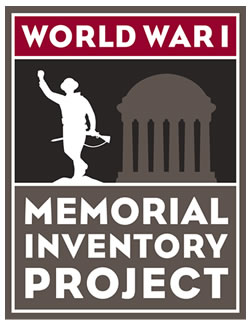
wwi-inventory.org/

wisconsinhistory.org/

www.uswarmemorials.org/
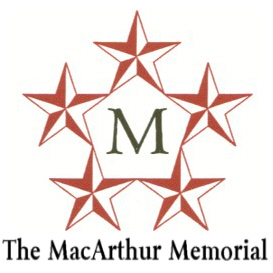
www.macarthurmemorial.org/
|
|

April 1914
The Assassination Plot Is Hatched
In April 1914 Gavrilo Princip was in Belgrade, where he associated with a number of Serbian students in town cafes and conceived a plan for the assassination of Archduke Franz Ferdinand. He shared the plan with his acquaintance Nedeljko Cabrinovic, also in Belgrade, who held similar views and agreed at once to participate in the attempt.
 The Conspirators in Court, Princip Circled
Attempts on the Archduke's life were a frequent topic of conversation in the circles in which Princip and Cabrinovic moved, as the Archduke seen as a dangerous enemy of the Serbian people.
Princip and Cabrinovic desired at first to procure the necessary bombs and weapons from Serbian Major Milan Pribicevic or from the Narodna Odbrana, [the Black Hand] as they lacked the money to purchase the weapons. Since both Pribicevic and Zivojin Dacic, a leading member if the Black Hand, were absent from Belgrade, they then tried to get the weapons from their acquaintance Milan Ciganovic, a former Komitadji currently working for the State railways.
A Fresh, Insightful
Look at the Tragedy
|
|
Princip contacted Ciganovic though a friend and discussed the assassination plan with him. Ciganovic endorsed the plan and indicated he would consider providing weapons. Cabrinovic also talked with Ciganovic about the weapons.
At Easter Princip took Trifko Grabez, also in Belgrade, into his confidence. In his later confession, Grabez admitted his willingness to take part in the attempt. In the following weeks Princip repeatedly discussed the plans with Ciganovic, who meanwhile had reached an understanding with his close friend Serbian Major Voja Tankosic to provide the Browning pistols Princip used on June 28 to kill the Archduke and his wife Sophie.
Sources: Austrian Court District of Sarajevo Record; (I hope readers will forgive the inexact of Slavic lettering and symbols, our software just isn't that sophisticated.)
|
|

Flyers and application form for 2014 "Opening Moves" and
"Miracle of the Marne" Trips Now Available
(download pdf file here)

Click on Image to Send Email
|
|
|

|

The Editors Recommend
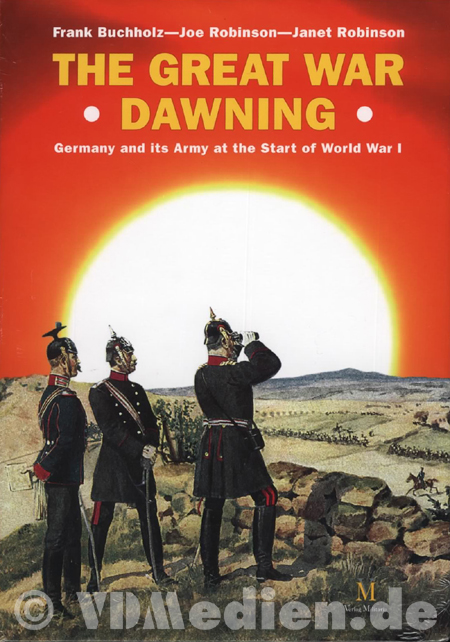

This work fills a huge gap in English language sources. Part resource book, part detailed and well-illustrated history, The Great War Dawning is filled with fresh facts and background material on the German Army that went to war in 1914 and its early operations.
The Imperial German army in 1914 was not the juggernaut that many presumed; rather, it was a force mired in tradition that had developed many structural weaknesses. Most English-language histories of the Great War's battles are based on British sources; the authors of this book based their analyses on many original German sources. With an extensive bibliography that includes German language sources (many unpublished), the reader is presented with a different view of the conflict.

Advancing Troops of German Second Army, Near Gozée, Belgium
This will become a most important English language book on the German Army as it entered World War I. It explains the social, political, and economic structure of the country as it relates to the German military. The Great War Dawning is thus far the only English-language source that explains how the German Army — coupled with training and doctrine for both active and reserve forces. More important, this book discusses the structural issues in the German Army that led directly to its failure at the Battle of the Marne, when leadership issues, logistical issues, and the misuse of cavalry created significant fissures that could have been corrected before the war.
This is a different view of the 1914 campaign than our readers may be used to. The Great War Dawning presents a critical look at the doctrine of the time and how the German leadership's failure to modernize its outmoded theories and battle plans led to the downfall of Imperial Germany's ambitions in the opening hostilities.
|

The Villar Perosa-Revelli 9mm Machine Pistol
|
The Villa Perosa-Revelli 9mm machine pistol was the first portable machine gun used in World War I. This Italian weapon consisted of two nickel and steel-barreled pistols connected together and mounted on a biped or directly on a shield.
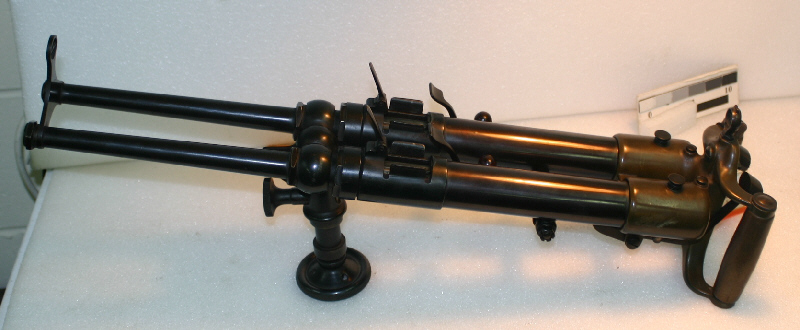
Museum Display: Note Double-Barrel Design and Handgrips
The breech had two openings, the top one to insert a 25-round semi-lunar [banana] clip and the lower one to eject the spent cartridges. Firing the Italian 9mm Glisenti pistol round, the weapon was underpowered by the standards of the other nations' 9mm rounds. Other weaknesses included a high rate of fire (300 rounds per minute per barrel, theoretically much higher) and a short effective range. At full fire, It would burn up its 25 round clips in seconds. Because its effective range was only about 100 meters (again, it had a much-greater theoretical range of 800M) reloading was extremely risky for the gunner.
The Villar Perosa was originally intended for use by aircraft but was found unsuitable. Ground troops experimented with it, most successfully the Alpini mountain-specialist soldiers, who appreciated its portability. Its flaws, though, ultimately led to its phasing out by 1918.
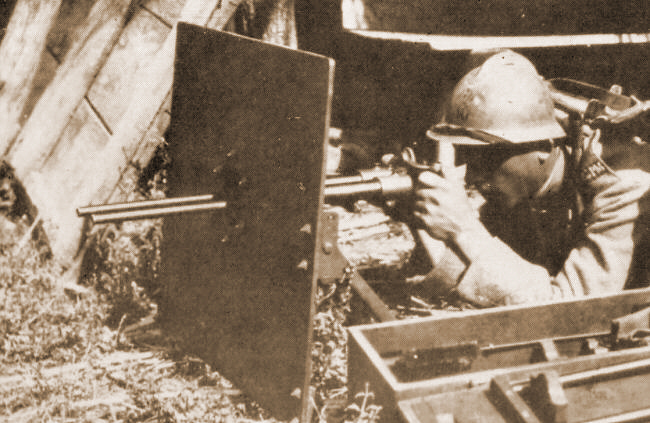
Mounted on a Shield
|
|
|

Hill 60
Last Major Battle at Gallipoli
At the beginning of August 1915, Hill 60, which commanded the shoreline communications links between the forces at Anzac and Suvla, was in Turkish hands. Hill 60 was included as an objective for the renewed Suvla offensive of 21 August. Its capture would secure the link from Suvla Bay to the Anzac beachhead. On 22 August, the hill was attacked from Anzac by the Canterbury and Otago Mounted Rifles from New Zealand. They succeeded in seizing part of the Turkish trench system but could not dislodge the Turks from the hill. Six days later, the remnants of the whole New Zealander brigade (about 300 men, down from the 1865 who landed in May) made another daylight attack that extended the line but again failed to capture the target.
 Skeletal Remains on Hill 60 Afterward
The initial attacks were followed later by the 18th Australian Infantry Battalion and supported on the flanks by other troops. Hill 60 was partly captured and on 27-29 August the captured ground was extended by the 13th, 14th, 15th, 17th, and 18th Australian Infantry Battalions, the New Zealand Mounted Rifles, the 5th Connaught Rangers, and the 9th and 10th Australian Light Horse. The summit of Hill 60 was never wrested from the Turks but, by holding the seaward slopes, the ANZAC flank was secured and the link with Suvla opened. In 1920, Major Fred Waite, New Zealand's historian of the Gallipoli campaign, wrote, "The struggle near Kaiajik Aghala was the last pitched battle on the Peninsula."
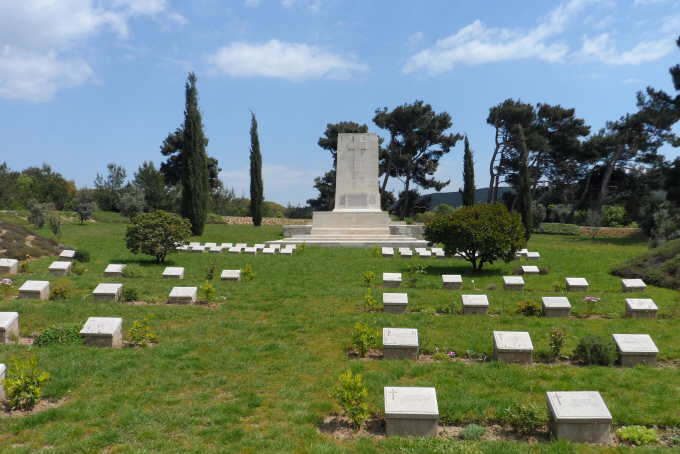 Hill 60 Cemetery and New Zealand Memorial Today
The British historian Robert Rhodes James later wrote that "For connoisseurs of military futility, valour, incompetence and determination, the attacks on Hill 60 are in a class of their own."
The position, however, was held until the evacuation in December.
Sources: New Zealand and Australian governmental and veterans' websites
|
|
Our mystery aviator is Major (later General) Carl "Tooey" Spatz.
Thanks to each and every one of you who has contributed material for this issue. Until June, your editor, Mike Hanlon. |
|
 (Or send it to a friend)
(Or send it to a friend)
|
Design by Shannon Niel
Content © Michael E. Hanlon
|
|
|









